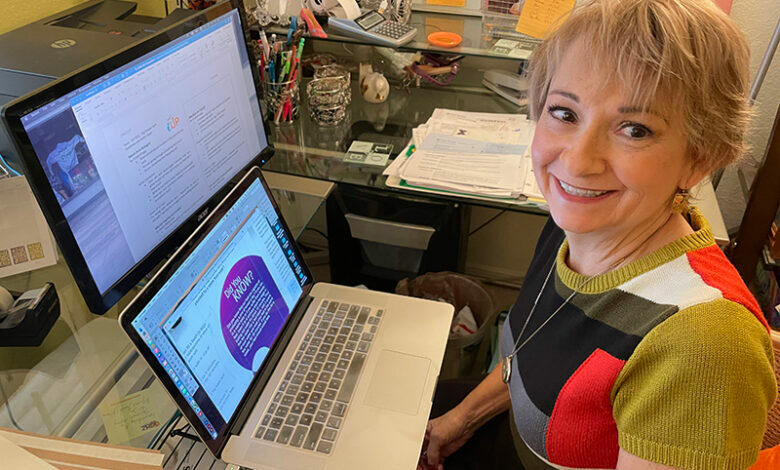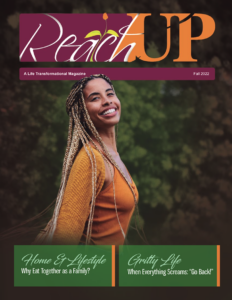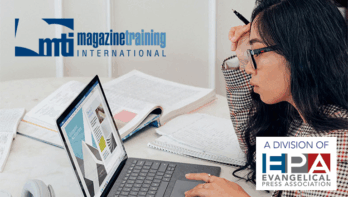
Crystal Wacker Knapp stood at the copy machine in the church office, the product of her blood, sweat and tears face down on the glass. With the lid closed, the machine hummed a consistent cadence, augmented by a periodic flash of light:
Chick-a-da, chick-a.
Chick-a-da, chick-a.
Chick-a-da, chick-a.
Chick-a-da, chick-a.
The rhythm was a song of promise that energized Knapp. Would this, Plan B, be the catalyst to taking her dream—creating a magazine for the most marginalized women in America—to the next level?
“We started out really small and only (did) as much as I could afford,” Knapp said. “We had no financial support. Little by little, word of mouth, a check here and checks there. That’s how it began.”
By the time Knapp found herself in front of that copier, she had already published five digital editions of the quarterly, eight-page, but was expanding with a print version.
 Reach UP featured content similar to many national women’s magazines, but was designed for a mostly-forgotten audience: those coming out of sex trafficking, domestic violence, physical abuse, crisis pregnancies, and the formerly incarcerated. Their life experiences meant many faced limitations on reading, options and disposable income.
Reach UP featured content similar to many national women’s magazines, but was designed for a mostly-forgotten audience: those coming out of sex trafficking, domestic violence, physical abuse, crisis pregnancies, and the formerly incarcerated. Their life experiences meant many faced limitations on reading, options and disposable income.
“Reach UP was focused for the inner city because that was my world,” Knapp said.
The concept bubbled up out of nowhere. Although Knapp worked in donor communications for Metro Ministries in New York City, publishing was never part of the equation. The seed was planted, though, when Knapp decided on a whim to bring armfuls of old magazines to a retreat for inner-city women. Even as she was stacking them on a table she second-guessed herself. Would these women be able to relate to content designed for middle-class suburbanites?
“They scarfed up these magazines,” Knapp said. “In that moment I realized there is nothing out here for these women; nothing that understands their limited buying power, their desires.”
With nine years of inner-city work on her résumé, Knapp understood the unique narratives of women living in some of the roughest ZIP codes in America. During her tenure on the city’s east side, the Vanguard University grad served a 6- by 13-block neighborhood.
“It was a very dangerous area,” she said.
Although Knapp had the skills for writing and basic layouts—and was confident she could create pertinent content—she was daunted by the prospect of creating a large enough subscription base to distribute her niche publication. She tabled the project.
“I remember praying and telling God, ‘Well, you gotta find somebody to do this because this needs to be done,’” Knapp said.
Three years later, after a move to Fort Lauderdale, the idea resurfaced.
“It’s as clear as day,” she said. “I suddenly knew how to start. God was downloading a plan, and I leaned in hard for His help. I called a few friends, and we went to work.”
The plan was to supply magazines to nonprofit ministry leaders already working in the inner-city space, who would use them as an outreach tool for their clients.
In December 2007, the first of several online editions of Reach UP was published. Then came a setback. Another friend reviewed the online magazine and offered an honest critique.
“This is great but it’s not going to do my women any good,” her friend shared, reminding Knapp her target audience had limited internet access.
That’s when Knapp turned to her missions-minded pastor, who gave her permission to use the church copier to publish Reach UP. She did so for 18 months, churning out 640 magazines each quarter before securing a professional printer.
Today, Reach UP prints 14,000 copies of the magazine each quarter, with a nearly all-volunteer crew. An overseas graphic designer is the only paid staff. Most have been with Knapp since the early days of the publication.
“They’re friends and God puts it on their heart because I think if He didn’t, they might have faded away a long time ago,” said Knapp, who now lives in Mesa, Arizona.
A flexible model
Now, 15 years in publication, the glossy, four-color magazines are distributed to 160 inner-city nonprofits, with the entire operation funded through donations, mostly from friends and family.
Each edition includes a section on the back panel that ministries can use to personalize the magazine before distributing. Inside, readers can find tips on relationships and family, home and lifestyle, beauty and fitness, as well as deeper topics, including “my spiritual life,” “gritty life issues” and “becoming a better me.”
Over time, Reach UP’s base of articles has expanded to include contributors who serve the target audience, including women who write about their own struggles and triumphs. Using that material requires a great deal of time, patience and flexibility.
“I’ve always been amazed how God puts (the editions) together,” Knapp said. “I’ve had some first-person stories written in pencil that they could barely put sentences together. She said what needed to be said, and so we let that go through.”
Within two years of printing the magazine, the team launched a Spanish edition. The crew is also using an artificial intelligence app to convert Reach UP articles into audio stories, which are uploaded on the website, designed for graduates from inner-city programs who no longer have access to the free magazines.
“We hope to continue the relationship,” Knapp said.
Knapp admits the process has been “learn as you go.”
“I just kind of do the next thing and the next thing,” she said.
Seeking to grow nationwide
The ultimate next thing, Knapp said, is expanding the publication so it has nationwide influence for often-muted voices. She has been searching for grants to expedite expansion.
“If I were to talk about a God dream, I would love to see Reach UP as one of those things that God uses to touch that whole demographic nationwide, but that’s in His hands,” the publisher said.
Knapp likened it to a weather system.
“Rain produces ripples on a lake, but a sustained downpour raises the level,” she said, adding that if Reach UP could become that “sustained downpour, that would be amazing because that’s to God’s glory. I’m not building my kingdom. I just see there’s nobody else doing it.
Why shouldn’t Christians be?”
Learn more about Reach UP magazine at reachupmag.org. The digital version of the magazine can be accessed at myreachup.org.
— by Lori Arnold
Lori Arnold is a freelance journalist. She is a veteran news reporter covering community journalism with the Daily Californian first as a reporter, community, and features editor and eventually the news editor. For sixteen years she served as managing editor for the Christian Examiner newspaper network and Refreshed magazine. Learn more at storylorimedia.com.
Posted Dec. 22, 2022



